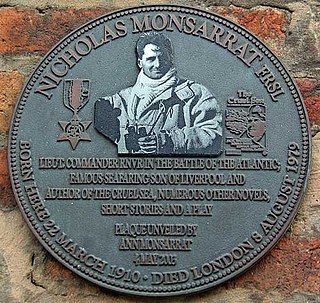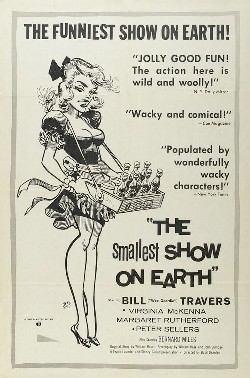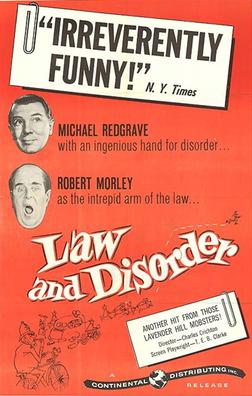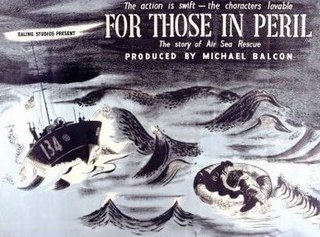
Lieutenant Commander Nicholas John Turney Monsarrat FRSL RNVR was a British novelist known for his sea stories, particularly The Cruel Sea (1951) and Three Corvettes (1942–45), but perhaps known best internationally for his novels, The Tribe That Lost Its Head and its sequel, Richer Than All His Tribe.

The Smallest Show on Earth is a 1957 British comedy film, directed by Basil Dearden, and starring Bill Travers, Virginia McKenna, Peter Sellers and Margaret Rutherford. The screenplay was written by William Rose and John Eldridge from an original story by William Rose.

The Cruel Sea is a 1953 British war film based on the novel of the same title by Nicholas Monsarrat. The film starred Jack Hawkins, Donald Sinden, Denholm Elliott, Stanley Baker, Liam Redmond, Virginia McKenna and Moira Lister. The movie was made by Ealing Studios seven years after the end of the Second World War, and was directed by Charles Frend and produced by Leslie Norman.

Basil Dearden was an English film director.

Back-Room Boy is a 1942 British comedy mystery film directed by Herbert Mason, produced by Edward Black for Gainsborough Pictures and distributed by General Film Distributors. The cast includes Arthur Askey, Googie Withers, Graham Moffatt and Moore Marriott. It marked the film debut of Vera Frances. The original story was written by J.O.C. Orton, Marriott Edgar and Val Guest. A man from the Met Office is sent to a lighthouse on a remote Scottish island to monitor the weather, where he hopes to escape from women, but soon finds the island overrun by them.

Fountain Studios was an independently owned television studio in Wembley Park, northwest London, England. The company was last part of the Avesco Group plc.

Only Two Can Play is a 1962 British comedy film directed by Sidney Gilliat starring Peter Sellers, Mai Zetterling and Virginia Maskell. The screenplay was by Bryan Forbes, based on the 1955 novel That Uncertain Feeling by Kingsley Amis.

Spare a Copper is a 1940 British black-and-white musical comedy war film directed by John Paddy Carstairs and starring George Formby, Dorothy Hyson and Bernard Lee. It was produced by Associated Talking Pictures. It is also known as Call a Cop. The film features the songs, "I'm the Ukulele Man", "On the Beat", "I Wish I Was Back on the Farm" and "I'm Shy". Beryl Reid makes her film debut in an uncredited role, while Ronald Shiner appears similarly uncredited, in the role of the Piano Mover and Tuner.

Out of the Clouds is a 1955 British drama film directed by Basil Dearden and starring Anthony Steel, Robert Beatty and James Robertson Justice. An Ealing Studios production, the film is composed of small stories dealing with the passengers and crew on a day at London Airport.

Train of Events is a 1949 British portmanteau film made by Ealing Studios, directed by Sidney Cole, Charles Crichton and Basil Dearden and starring Jack Warner, Peter Finch and Valerie Hobson. The film premiered on 18 August 1949 at the Gaumont Haymarket in London. In the film, as a train is heading for a crash into a stalled petrol tanker at a level crossing, four different stories are told in flashback.

Law and Disorder is a 1958 British crime comedy film directed by Charles Crichton and starring Michael Redgrave, Robert Morley, Joan Hickson, and Lionel Jeffries. It was based on the 1954 novel Smugglers' Circuit by Denys Roberts. The film was initially directed by Henry Cornelius, who died while making the film. He was replaced by Charles Crichton.

The Gay class were a class of twelve fast patrol boats that served with the Royal Navy from the early 1950s. All were named after types of soldiers or military or related figures, prefixed with 'Gay'. The class could be fitted as either motor gun boats or motor torpedo boats, depending on the type of armament they carried.

Dancing with Crime is a 1947 British film noir film directed by John Paddy Carstairs, starring Richard Attenborough, Barry K. Barnes and Sheila Sim. A man hunts down the killer of his lifelong friend.

Saloon Bar is a 1940 British comedy thriller film directed by Walter Forde and starring Gordon Harker, Elizabeth Allan and Mervyn Johns. It was made by Ealing Studios and its style has led to comparisons with the later Ealing Comedies, unlike other wartime Ealing films which are different in tone. It is based on the 1939 play of the same name by Frank Harvey in which Harker had also starred. An amateur detective tries to clear an innocent man of a crime before the date of his execution.

Manuela is a 1957 British drama film directed by Guy Hamilton, starring Trevor Howard and Elsa Martinelli. It was released as Stowaway Girl in the United States.

Convoy is a 1940 British war film, produced by Ealing Studios, directed by Pen Tennyson and starring Clive Brook, John Clements and Edward Chapman. Convoy was Tennyson's last film before he was killed in an aircraft crash, while serving in the Royal Navy.

For Those in Peril is a 1944 British war film produced by Ealing Studios that marked the directorial debut of Charles Crichton. The film was developed from a short story by Richard Hillary, an RAF pilot killed in action in January 1943. The basic and relatively slight storyline of For Those in Peril was an end to produce a film with a documentary feel and an element of wartime propaganda. The film stars Ralph Michael and David Farrar.

Feather Your Nest is a 1937 British musical comedy film directed by William Beaudine and starring George Formby, Polly Ward and Enid Stamp-Taylor. It contains Formby's signature tune, Leaning on a Lamp-post.

John Boxer was a British film and television actor. His television appearances included Emergency – Ward 10, Dixon of Dock Green, The Saint, Randall and Hopkirk (Deceased), The Onedin Line and The Life and Times of David Lloyd George.
Peter Bezencenet (1914–2003) was a British film editor and film director. He co-scripted the 1936 film Conquest of the Air. He was employed by the Rank Organisation on a number of films during the 1950s, including several for Ealing Studios. He also acted as location director for the television series Richard the Lionheart in the early 1960s. During the 1960s he directed four films and episodes of the TV series The Pursuers.



















